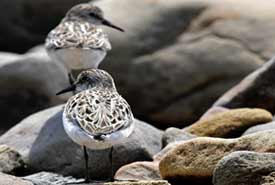NCC's Shorebird Reserve and Interpretive Centre
An internationally renowned haven for shorebirds in Atlantic Canada

Semipalmated Sandpipers (Photo by Jordan Myles/ NCC staff)
Johnson’s Mills is an example of a critical stopover for migrating shorebirds in New Brunswick. Every summer, massive flocks of shorebirds journey through the Bay of Fundy from the Canadian Arctic before heading to South America. Johnson's Mills becomes the stage for one of nature's great migrations, as its mudflats and beaches serve as a temporary stopover for flocks of shorebirds numbering up to a quarter of a million individual birds
As important work still needs to be done, staff and researchers will be onsite at the shorebird reserve to make sure that the habitat and birds are protected.
Treading lightly around the shorebirds
Please stay off the beach two hours before to two hours after high tide.
During their short stay, it is imperative that the birds be able to feed and rest undisturbed. Shorebirds can't swim, which makes them vulnerable at high tide when they need to rest on the beach. As a result, we ask that visitors please stay off the beach during high tide.
Shorebirds are easily startled and something as simple as a passerby can scare them into flight, depleting the fat stores they need for their long flight south.
Tips for watching the shorebirds:
- Keep your distance and stay on the road.
- Walk softly.
- Don't wave or shout.
- Drive slowly and quietly .
- Don't litter.
- Leave your pets at home.
Conservation values
Semipalmated sandpipers are the most common shorebird stopping over at the Upper Bay of Fundy to feed and rest. In just a few weeks, the birds double their weight by eating mud-dwelling invertebrates that are exposed at low tide before leaving for South America.
Other shorebirds you can see include:
- semipalmated plover
- least sandpiper
- sanderlings
- black-bellied plover
- white-rumped sandpiper
- ruddy turnstone
Check out a time-lapse of the shorebirds in action, below:
Our vision for Johnson's Mills
NCC is currently responsible for 26 properties here and wishes to secure additional lands at Johnson's Mills. Since 1994, NCC has worked with partners and willing landowners to acquire critical shoreline areas. Stewardship remains a key focus, and NCC is currently raising money for an endowment fund and for future land securement. This fund will provide for the ongoing management of all of the area properties, as well as for the interpretive centre.
Support
The Nature Conservancy of Canada wishes to recognize and thank the New Brunswick Wildlife Trust Fund (NBWTF), the New Brunswick Environmental Trust Fund, Canada Student Jobs, the Jack Iwanicki Fund and donations from the public for its generous and ongoing support of our work at Johnson's Mills. Financial contributions from NBWTF for NCC projects over many years have been instrumental in helping us carry out our conservation and stewardship efforts. For more information on the New Brunswick Wildlife Trust Fund, visit nbwtf.ca.
Johnson's Mills at a glance
- It earned international prominence when it was added to the Ramsar list of Wetlands of International Importance.
- It was also designated as Canada's first Western Hemisphere Shorebird Reserve.
- The pebble beach and mudflats make the area the perfect resting place for migratory shorebirds.
- Bird Studies Canada named Johnson's Mills an Important Bird Area.
- Johnson's Mills is located eight kilometres from Dorchester, New Brunswick, and 43 kilometres south of Moncton.
Visitor information
The Interpretative Centre is open daily in July and August, starting July 3. Visitors can call the Centre at 506-379-6347 to enquire about high tide times and bird migration numbers.
Download a copy of the summer tide schedule and Shorebird Interpretive Centre hours to check the best time to see the birds!
Directions
From Nova Scotia and Prince Edward Island: Trans-Canada Highway – Bridge St., Sackville, NB
- Exit #506 Route 106 W for 16 km to Dorchester Route 935, 8 km to Centre.
From New Brunswick: Trans-Canada Highway – East Memramcook, NB.
- Exit #488 follow Route 106 E for 15 km to Dorchester Route 935, 8 km to Centre.
Amenities on-site
- Interpretive centre with ramp access
- Observation deck
- Compost toilet
Want to read more about Johnson's Mills?
Top 10 facts about why Johnson's Mills is a perfect stop for shorebirds >





